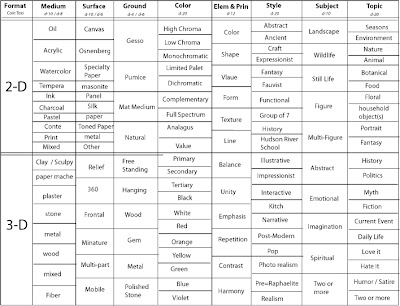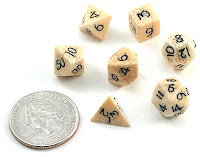
One of my favorite things to do is play D&D. Another favorite thing is to paint, draw or sculpt something. Occasionally I get hit with the dreaded Artist's Block and need a way to get past it. This seemed like a good idea at midnight last night and since I'm still having fun with it today I figured I'd post it.
I also sent it to every artist I know via e-mail, so it's probably going up on several other blogs.
I should mention that Doug Anderson, one of my professors at SUNY Geneseo was the first to introduce me to this concept. As I recall, his chart had 10 columns up and across and you did some kind of diagonal thing to get to the project idea. I must admit that I never understood it despite the rest of my fellow students grasping it immediately. I promptly lost the paper, but never forgot the concept.
To use the chart as-is you will need a set of gamer-dice and a coin. See all the pretty shapes?

How it works:
If you have no idea what you want to do, start with the first column. 2-D or 3-D can be determined by flipping a coin or an odds / evens die roll.
Let's say you got heads for 2-D
Now, roll a d-10 (a 10 sided dice), I rolled a 3, so I count down the column and come to watercolor
Roll another d-10 for surface (only a few apply). I got paper (watercolor paper) and we know it's going to be natural, not treated with anything.
For color, roll a d-20 (the almost round one that lives under heavy couches) and we come up with complementary. Then again for a completely random selection of blue. So blue and orange are our colors.
Main element or principle will be a d-12 that turns out to be line.
Style is a d-20 roll of 1 which is Abstract
For subject I roll a d-10 and get multi-figure.
And for topic I roll another d-20 and get botanical.
Now, here is what I've got in short:
2-D
watercolor
paper
complementary colors: blue & orange
line
abstract
multi-figure
botanical
Here are a couple things I could do with this:
- A blue & orange watercolor of linear abstracted ferns. Wet-on-dry so the colors vibrate.
- A range of neutrals from blue & orange in the background with linear abstracted lichens or mosses covering the surface of the paper.
If you have an idea of what you want to do, but need to flesh it out, or make an assignment into something more, just use a few columns.
"I am going to paint a nude figure in oils on gessoed canvas today."
You can roll for style, topic, elements & principles and major color themes.
Given:
2-D
oil
canvas
gesso
figure
Random:
color - violet
Element - value
style - Realism
topic - Fantasy
Idea: Now I know that I am using mainly violets in this painting with an emphasis on value. I'm going to keep it realistic, so it's probably not going to get too distorted with either color or form, it'll just have a lot of violet with a full range of darks and lights. I'm also adding a fantasy element, so depending on the pose I may add a critter, costume or interesting environment. The final product will probably end up being more Surreal than Real, but I'm OK with that.
This can be general or very specific. Totally up to you. If something doesn't work, just re-roll.
This chart will work best if you fill it in with your own ideas for mediums, surfaces, grounds, styles, subjects and topics. It can be used to generate lesson plans for art teachers, fleshing out hazy ideas and getting rid of a bad case of Artist's Block.
I'm happy with it and have had a lot of fun playing with it today.
2 comments:
Thank you so much for this. This is exactly the sort of thing I've been combing the web for every once in a while when I've gotten completely and utterly stuck about what to do next.
You're welcome. I'm glad it helped someone other than me.
All my art friends were confounded... they never have trouble thinking of something creative to do.
Post a Comment